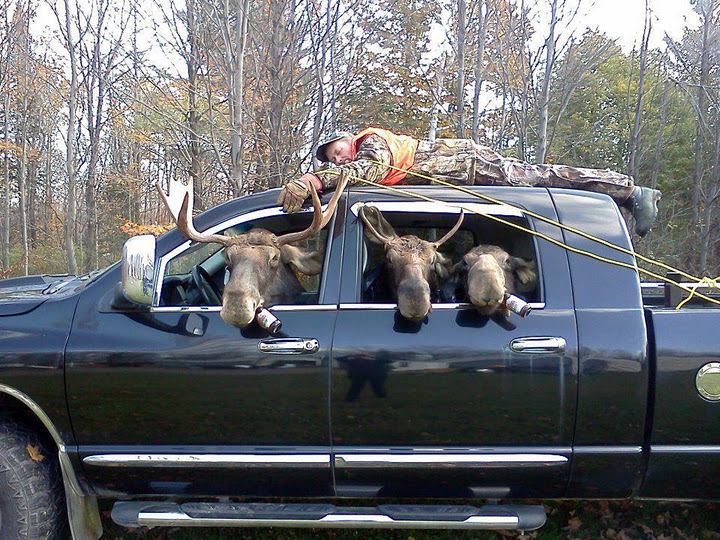A hunter’s nightmare
Posted By RichC on October 29, 2011
Since hunting season here in Ohio is in full swing, I thought this photo shared on G+ was funny enough to share. You’ve heard of “Planet of the Apes” … well this hunter’s dream nightmare would be “Planet of the Moose.” (see plural note below)
The word “moose” came to us from Algonquian Indians. Consequently its plural, instead of being “mooses” or “meese”, is the same as the singular. That is true of most Indian names whether of a tribe, such as the Winnebago and Potawatomi, or of an object such as papoose. It is also true of many wildlife names not of Indian origin — for example: deer, mink and grouse.
Moose are the monarchs of the north woods, particularly forests surrounding innumerable lakes and swamps. They are splendid swimmers fond of wading into waters where they dredge up lily roots and other aquatic plants. On land, although they do graze on grasses and sedges, moose are primarily browsers feeding on the leaves and tender twigs of hardwood trees and shrubs, especially willows, in summer; on balsam and white cedar or other conifers in winter: on twigs and bark in early spring.
Moose range from Maine to Hudson Bay, northwest to Alaska, and south into Montana, Wyoming and Minnesota. There are a few on the Upper Peninsula of Michigan; and on Isle Royale there is a herd that has become too numerous because that is a national park isolated in Lake Superior. In Wisconsin and Michigan there are early records of moose almost as far south as Detroit but apparently they did not occur in Illinois.
A moose, blackish brown except for its paler belly and legs, is the largest of the deer family. A bull may stand from 5-1/2 to 6 feet tall at the shoulders and weigh from 900 to 1400 pounds. On the Kenal Peninsula of Alaska they become even taller, heavier, and are more richly colored. He is a formidable but grotesque critter. His body, from the high-humped withers to the absurd little tail, seems too short for the long gangling legs. His gait appears awkward because the forelegs are longer than the hind ones but a moose can trot at incredible speed. His short thick neck supports a long narrow head with large nostrils and a broad overhanging flexible muzzle. Dangling from the throat is a long hairy “bell” which, in old age: shrinks to a sort of pouch.
On this massive head and neck the bull carries a tremendous pair of flattened antlers with perhaps more than 30 prongs or “points” and their spread may exceed 6 feet. Like other deer, these are shed each winter and grown anew during summer. The cows have no antlers and are about 25 percent smaller than the bulls and appear even more gaunt and ungainly. Their calves, frequently twins, are born in late spring.
Although they “yard” together in spring, during most of the year, moose are solitary secretive animals and very wary of mankind. In autumn, however, the bulls roam the forests in search of mates, bawling invitations to any cow and challenges to any male — day or night. There are vicious battles, sometimes fatal. At that time they are in prime shape, with new antlers prized as trophies, and are stalked by daring hunters who lure them by imitating their calls with birch bark horns. Then they are surly, fearless and dangerous. A bull moose, cornered or wounded, will charge like an angry elephant.

Comments